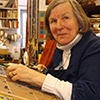 Mary Bartlett came to Dartington in 1963 as a horticultural student. After her training she became responsible for the glasshouses, nursery and walled garden.
Mary Bartlett came to Dartington in 1963 as a horticultural student. After her training she became responsible for the glasshouses, nursery and walled garden.
She is the author of several books, including the monograph Gentians, and Inky Rags, a review of which can be found on the Dartington website. She is now the tutor for bookbinding in the Crafted @ Dartington department. More blogs from Mary
Mary’s note: ‘I began this comment before lockdown and have continued the research and added to the original.’
As I begin to plant the walled garden at Martins that my late husband Bram and I restored 30 years ago and that I’ve cared for ever since, memories and questions fill my mind.
Below: ‘before’ and ‘after’ images of Mary’s walled garden



In the small orchard the ground cover of perennial comfrey needs a prune. On a sunny day the bumble bees still hum. Thank goodness – but when we planted the trees we could sit and watch bats flying, and the noise of the frogs and toads mating in the pond could be heard from the house. Not now though – like so much of our countryside it has fallen silent.
Back in 1962, Rachel Carson’s Silent Spring sounded one of the first environmental alarms. It’s a lifetime since it was published. People don’t recognise her name or remember DDT, the pesticide she saw wreaking havoc. But the same story of ignorant mistake and cover-up keeps repeating.




My interest is in the listing of Burbank plums in the famous 1935 Dartington gardens catalogue – see The Forgotten Gardener: Architect of Nature, Wilbur Hall, who knew him well. ’What killed Luther Burbank, at just that time and in just that abrupt and tragic fashion,’ Hall writes, ‘was his baffled yearning, desperate effort to make people understand’.
I have manged to track down two of his varieties and have planted them this winter.
He mentions the Russian, Vavilov, who visited him in 1921. Origin and Geography of Cultivated Plants is a classic and changed perceived wisdom. Leonard Elmhirst mentions him in his Trip to Russia, 1932.
Sadly another genius who died in 1943 of starvation in prison, ordered by Stalin.



Growing up on the edge of Dartmoor influenced my life. We had a railway allotment, now a duel carriageway. The water meadow where we kept our horses is a building site as is much of the open farmland. I spent 6 years, researching and speaking at every planning meeting in a local council which wanted to build on ground untouched since the Devonian period in geological times. I printed a book, Land at Sutton Close to record the events.



The last of the apples saved from the autumn are made into juice. We wait for the roses to flower to make rose petal cordial.
I look at the moon calendar and choose the seed from the box, go out into the greenhouse and sow. Talk to the pheasant who plods slowly picking here and there. Observe the blue tit nibbling the aphids on the roses. Watch the sparrow hawk as she decides her best move.
Look forward to the warmer weather and the abundance it will bring. Plant crops for the coming winter.
Picture credits: Bill Simpson

Amazing to see the old photos and how the walled garden once used to look. I wonder how many hours work has gone into it. They’re spraying Round-Up now instead of DDT: the product changes, but the attitude hasn’t yet. Ros was drinking from the clear stream but won’t now – Round-Up poisoning the land.
As you point out, there have been many warning voices throughout the 20th century, but we’re still not listening. It seems that year by year more and more is paved over and cut down. We no longer work with nature, we subdue it and torture it.
Perhaps the mouse was drawn to the book by an ancient memory of its predecessors who were drawn to the ships and vessels, including the Beagle. The forefathers lived under battened down hatches, now this mouse is battened by the book! (oh dear, I’m trying too hard)
Anyway, great article as always Mary; plenty of springboards for further exploration.